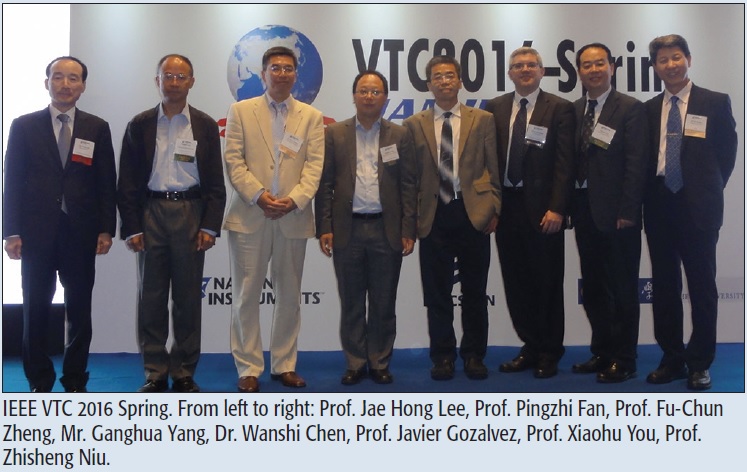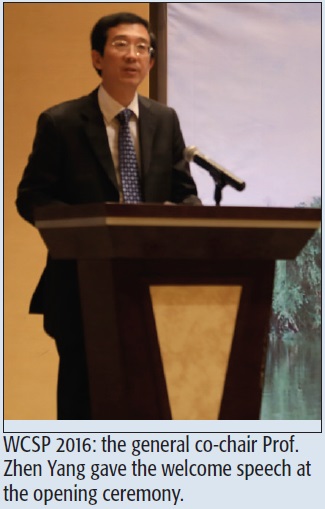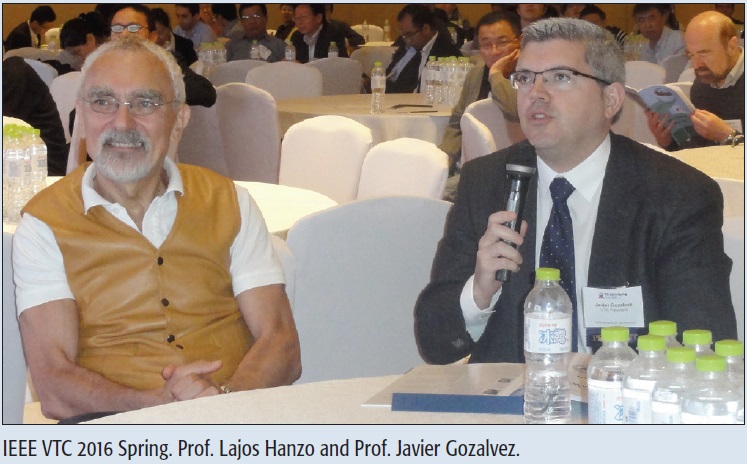
The IEEE ComSoc Nanjing Chapter was established in October 2009. Currently, the IEEE ComSoc Nanjing Chapter is responsible for the members and activities in three provinces of China, Jiangsu, Zhejiang, and Anhui, one of the most important and prosperous areas in China. The activities of the Chapter in 2016 were focused on the following main areas:
- Organizing or contributing to the organization of international conferences on communications.
- Organization of presentations, short courses, and seminars offered by world-class specialists from well known institutes.

IEEE Vehicular Technology Conference (VTC) 2016 Spring
The 83rd VTC (VTC 2016 Spring) was held on 15–18 May 2016 in Nanjing. VTC Nanjing was organized by Southeast University and co-sponsored by the IEEE ComSoc Nanjing Chapter. The general co-chair Prof. Xiaohu You, the technical program co-chair Prof. Fu-Chun Zheng, and the publicity co-chair Prof. Xiqi Gao were from Southeast University in Nanjing.
As one of the top conferences on communications and vehicular electronics, VTC has a long history of over 60 years and a well-established reputation in both IEEE ComSoc and the IEEE Vehicular Technology Society (VTS). VTC 2016 Spring in Nanjing was historic, as it was the first time VTC was held in China.

VTC Nanjing attracted more than 600 academics, engineers, and students from around the world. The conference’s technical program included one plenary panel, three keynote speeches, seven tutorials, seven workshops, more than 400 oral presentations, and more than 100 poster presentations. VTS president, Prof. Javier Gozalvez, praised VTC Nanjing as “one of the best VTC in history.”
International Conference on Wireless Communications and Signal Processing (WCSP) 2016
WCSP 2016 was held on 13–15 October 2016 in Yangzhou, China, organized by Nanjing University of Posts and Telecommunications and co-sponsored by the IEEE ComSoc Nanjing Chapter. WCSP 2016 brought together international researchers from academia and practitioners from industry to meet and exchange ideas and recent research advances on all aspects of wireless communications and signal processing.

Following the great success of WCSP 2009-2015, WCSP 2016 attracted more than 350 academics, engineers, and students from around the world. There were a total of 779 submissions, which were rigorously and independently peer-reviewed by 193 TPC members and many reviewers. Based on relevance, originality, technical contributions and presentation, 310 high quality papers were accepted (an acceptance ratio of 39.79 percent). Accepted papers were grouped into 49 sessions within seven technical symposia. Five keynote speeches were delivered by Prof. Nirwan Ansari, Prof. Wei Zhang, Dr. James Kimery, Prof. Rui Zhang, and Prof. Dan Schonfeld.
WCSP 2017 will be organized by Southeast University in Nanjing.
A Quick Look at other Activities of the Nanjing Chapter in 2016
During 2016, the National Mobile Communication Research Laboratory at Southeast University has hosted a number of lectures and seminars by distinguished experts in communications, listed below.
- Prof. Eric Klumperink provided a fresh look at cognitive radio transceiver chips on 1 March.
- Profs. Pascal Lorenz and Abbas Jamalipour spoke about architectures of next generation wireless networks and software defined dense cellular networks on 12 April.
- Prof. Geoffrey Ye Li gave the lecture “LTE on Unlicensed Band” on 11 May.
- Prof. Rui Zhang shared his broad knowledge of wireless communication with unmanned aerial vehicles on 19 May.
- Prof. Jianwei Huang gave a talk on crowd-sourced mobile video streaming on 3 June.
- Prof. Koichi Asatani introduced network science and its applications to future networking on 6 June.
- Prof. Lu Gan delivered the talk “Structured Random Matrix Theory” on 27 June.
- Prof. Ying Cui kicked off the technical talk “Joint Caching and Multicasting in Large-Scale Cache-Enabled Wireless Networks” on 30 June.
- Prof. Sheng Yang gave a talk on fading broadcast channels with channel uncertainty on 12 August.
- Prof. Xiaodai Dong shared her knowledge about hybrid processing in massive MIMO for 5G on 19 September.
- Prof. Chengshan Xiao discussed the key problems in underwater acoustic MIMO communications on 10 October.
- Prof. Liuqing Yang gave a lecture on energy-harvesting relay networks and Prof. Rui Zhang presented a paradigm shift of wireless security on 17 October.
- Prof. Tony Q. S. Quek gave an overview of fundamentals and recent advances in 5G on 27 October.
- Prof. Hua Qian shared his broad knowledge of 5G IoT on 24 November.